SW Ag Center Feasibility Studies
Staying Strong on the Job: A Study of Exercise Benefits and Beliefs in Agricultural Workers
Nicholas J. Spokely, PhD
Purpose: The project aims to: 1) quantitatively measure the effectiveness of the Stay Strong, Stay Healthy exercise program for improving nursery workers’ physical capacity and psychosocial aspects of pain, fear of falling, sleep quality, general health, and self-efficacy to exercise and job performance and 2) qualitatively explore and assess participants’ beliefs and perspectives of health behaviors, barriers to personal health, and injury risk.
2023-2024
_______________________
Pilot Test of a Virtual Reality-Based Tractor Safety Training
Justin Pulley, PhD
Purpose: This project aims to: 1) describe the performance of participants who engaged in a tractor and machinery safety course; 2) determine the effectiveness of virtual reality-based educational technology used in tractor and machinery safety education; and 3) describe participants’ User Experience with the virtual reality-based machinery safety experience.
2024
_______________________
Assessment of Oklahoma Cattle Producer’s Knowledge and Awareness of Ticks and Tick-borne Diseases
Jonathon Cammack, PhD
Purpose: This project aims to: 1) assess knowledge of ticks and tick-borne diseases among Oklahoma cattle producers and 2) identify measures employed by cattle producers to protect against ticks and tick-borne diseases.
2024-2025
_______________________
Developing and Implementing an Integrated Wearable Sweat Sensor to Monitor the Health of Agriculture, Forestry, and Fishing (AgFF) Workers
Shawana Tabassum, PhD
Purpose: This project aims to: 1) develop a fully integrated wristband-style sensor to monitor cortisol levels in sweat and 2) develop a time-series profile for the selected sweat biomarkers in AgFF workers.
2024-2025
_______________________
Assessing the Health and Climate Change Risk Perceptions of Small Farmers through Application of the Health Belief Model
Rachel Hale, MA
Purpose: By using a cross-sectional survey research design and the theoretical framework of the Health Belief Model, this study seeks to explore the overall health status of small farmers in Arkansas, their climate change and health beliefs, and risk perceptions. Understanding the current health status alongside beliefs and risk perceptions of climate change and health will inform future interventions to address adverse physical and emotional health outcomes and seeks to build their adaptive capacity. In addition, the survey will inquire what current agricultural practices the small farmer has implemented that may help their farm operation to adapt to climate change.
2022 – 2023
An Agricultural Navigator Program for Crisis Response in Southeast Louisiana
Devin Wright, BA
Purpose: The project aims to: 1) better understand the post-hurricane experiences and needs of agricultural producers in Southeast Louisiana, a frontline region and 2) assess the adequacy and sustainability of current disaster response programs for agricultural producers. Broadly, the objective of this research is to improve agricultural producer resiliency as climate impacts continue to worsen.
2022 – 2023
Using ROPS Rebate Program Waitlist Data to Garner Support for Funding in Texas
Shelbie Lambert, MPH, The University of Texas Health Science Center at Tyler
Purpose: To determine if the Texas waitlist enrollees for the ROPS retrofit rebate program are clustered in hot spots for tractor incidents and if the enrollment took place near the time of an incident.
2022 – 2023
Needs Assessment of Total Worker Health Intervention Among Dairy Workers in West Texas
Anabel Rodriguez, PhD, University of Texas Health Science Center at Houston, School of Public Health
Purpose: To gather self-reported information concerning current health care services access and barriers as well as top five screenings, examinations, and programs most important to dairy workers employed in the region.
2021 – 2022
Organic Farmer COVID-19 Regional Survey
Daisy Rosero, MPH, University of New Mexico
Purpose: To conduct a cross-sectional survey of organic farmers related to COVID-19 as part of a larger study funded by the SW Ag Center.
2020 – 2021
Assessment of Wellness of School-based Agricultural Education Teachers: A Preliminary Study (OK)
Robert Terry, Oklahoma State University
Goal: To collect quantitative and qualitative data to assess the wellness and stress associated with teaching school-based agricultural education and compare various biometric measures to assess their effectiveness, practically and feasibility with our target population. The survey will also gather information on educators that are also involved in agricultural production.
2020 – 2021
Optimizing Text Messaging to Improve Occupational Health Outcomes Among Commercial Fishermen
Shannon Guillot-Wright, PhD, University of Texas Medical Branch
Purpose: To create a text messaging campaign based in the science and research of safety and injury prevention for commercial fishers.
2020 – 2021
Risk Perceptions and Safety Training in Agricultural Aviation
Nishita Sinha, PhD, Texas A&M Transportation Institute
Purpose: To identify demographic and work-related correlates of risk perceptions among Part 137 pilots and operators and the estimate the casual impact of Professional Aerial Applicators’ Support System (PAASS) program on risk perceptions.
2020 – 2021
Role of Protease from Poultry Organic Dust in Induction of Lung Inflammation (TX)
Shilpa Kusampudi, PhD, University of Texas Health Science Center at Tyler
Purpose: To identify the purified protease by mass spectrometry/amino-terminal sequencing and study its effects on inflammatory mediator production in airway epithelial and macrophage cells and in mouse lungs and determine the involvement of protease activated receptor pathway in the induction of inflammatory mediators by the protease.
2020 – 2021
Grow the Grower Safety and Health Training and Evaluation (NM)
Tammy Thomas, PhD, University of New Mexico
Purpose: To collaboratively develop and pilot a health and safety training module to address the specific health and safety needs of traditional farmers.
2020 – 2021
Agriculture Injury Surveillance Using a Regional Trauma Registry in East Texas – 2020
Allen Cook, MD, MS, The University of Texas Health Science Center at Tyler
Purpose: To improve reporting and surveillance of injury and illness in the agriculture sub-sector.
2019 – 2020
Short-term Pilot Feasibility Study of Gulf Coast Fishers Health Outcomes – 2020
Shannon Guillot-Wright, PhD
Purpose: This project addresses a NIOSH priority goal (6.1H) and will ultimately result in reduced fatal and non-fatal injuries for commercial fishers in the US and throughout the world.
20129 – 2020
Understanding the Exposure and Hazard Risks Associated with Nanomaterial Enabled Agriculture Products – 2020
Christie Sayes, PhD, Baylor University
Purpose: To develop a framework to qualitatively and quantitatively evaluate the release of engineered nanomatierals from different stages of the product life cycle and second to apply the framework to sustainable agriculture practices.
2019 – 2020
Improvement of Current Medical Surveillance of Coumaphos Exposure in TAHC Fever Tick Eradicators – 2020
Dalia Nessim, MD, MPH, PhD, The University of Texas Health Science Center at Tyler
Purpose: To improve the current medical surveillance of TAHC inspectors.
2019 – 2020
Role of Lung Epithelial Cell Exosomes in the Induction of Lung Inflammatory Mediators by Organic Dust – 2020
Vijay Boggaram, PhD, Biochemistry Research Faculty, The University of Texas Health Science Center at Tyler
Purpose: To study the effects of treatment of airway epithelial cells with poultry dust extracts on the production of exosomes and their inflammatory potential. Additionally, to study proteomic profiles of exosomes from control and treated cells to identify deferentially expressed proteins.
2019 – 2020
Examining the Effects of Hurricane Harvey Among Farmers in South Texas (TX)
Josie Rudolphi, PhD, National Farm Medicine Center
Purpose: To explore the relationship between resources loss and symptoms of psychological distress among agricultural producers in South Texas, while also examining the impact of Hurricane Harvey on the larger agricultural community.
2018 – 2019
NAAA Aerial Application Industry Survey: Pilots – 2019
Tim Struttmann, MSPH
Jackie Zawada
NAAA Aerial Application Industry Survey: Pilots- 2019
Purpose: The purpose of the survey was to: (a) gather data from the population of agricultural pilots on demographics, experience, scope of work operations, equipment, standard practices, and drift mitigation techniques: (b) gather data on risks, safety practices, risk perceptions and health for future training purposes; and (c) compare these data with data obtained from pilots surveyed in 2011 and to Operators where appropriate.
2018 – 2019
NAAA Aerial Application Industry Survey: Operators – 2019
Tim Struttmann, MSPH
Jackie Zawada
NAAA Aerial Application Industry Survey: Operators- 2019
Purpose: The purpose of the survey was to: (a) gather data from the population of Part 137 operators on demographics, experience, scope of work operations, equipment, standard practices, drift mitigation techniques, crops and acres treated: (b) gather data on risks, safety practices, risk perceptions and health for future training purposes: (c) compare these data with data obtained in prior surveys to identify trends; and (d) gather information on the aerial application of crop protection products and provide such data to the EPA and crop protection product manufacturers to aid in registration and reregistration, thereby increasing the availability of those products to the aerial application industry.
2018 – 2019
Assessing Readiness for Safety of Nanotechnology Application in Fisheries Industry (LA)
Ephraim Massawe, ScD, Southeastern Louisiana University
Purpose: To assess the readiness, in terms of the information and technological needs to support safe and sustainable handling of nanotechnology, including a toolbox of emergency preparedness protocols, exposure control measures, and training to better understand the existing regulatory framework.
2017 – 2018
Study Exposure to Antibiotic-Resistant Bacteria in Antibiotic-Contaminated Soils – 2018
Itza Medoza-Sanchez, PhD from Texas A&M University Health Science Center
Increase Residents’ Exposure to Agricultural Medical Knowledge and Delineating Factors – 2018
Melissa Fleegler, MD from the University of New Mexico Health Sciences Center
A Comparison of Physical Risk Factors Among Tree Planters Using Mechanized and Hand Planting Methods – 2017
Mark Schall, PhD, AEP, Auburn University
The Relationship Between Work Hours and Chronic Disease Among Farm Workers – 2017
Sarai (Sadie) Conway, PhD, MA, UT School of Public Health
Assessment of Sun-Safety Behaviors and Knowledge in the Farmworker Population in South Texas – In Progress
Shaadi Khademi, MD, The University of Texas Health Science Center at Tyler
Improving Public Health Surveillance of Occupational Injuries in Agriculture – 2016
Victor Cardenas, MD, MPH, PhD, FACE, University of Arkansas for Medical Sciences
Purpose: This project established a statewide surveillance system to assess the magnitude and characterize the occurrence and distribution of occupational injuries in the Agriculture, Forestry and Fishing sector in the State of Arkansas. The pilot will establish the collaboration required across state agencies to develop more effective occupational injury prevention programs in a mostly rural state.
Development of Guidelines to Conduct a MSFW Enumeration Profiles Study – 2016
Alice Larson, PhD
A Novel Diagnostic Approach to Traumatic Brain Injuries in Agricultural Workers – 2016
Joseph Neary, PhD, VetMD, Texas Tech University
Heat and Health: Developing Vulnerability Indicators for Agricultural Workers along the Texas-Mexico Border – 2016
Kai Zhang, PhD, UT School of Public Health
Pesticide Exposure Biomonitoring Using Sweat Patches: A Pilot Study – 2015
Joe Grzywacz, PhD, Department Chair, Florida State University Michael Merten, PhD, Associate Professor, Oklahoma State University
Latino Youth Development in an Agricultural Context – 2015
Michael Merten, PhD, Associate Professor, Oklahoma State University
Forces Experienced by the Body During Grain Entrapment and Rescue – 2015
Kevin Moore, ChE, MBA, Research Engineer, Oklahoma State University
Health and Safety Issues in Organic Farming – 2015
Francisco Soto Mas, MD, PhD, Associate Professor, University of New Mexico
Reaching South Texas Agricultural Workers through Lower Rio Grande Valley FQHCs – 2015
Sharon Huff, MD, Assistant Professor, The University of Texas Health Science Center at Tyler
Identification of Novel Pro-Inflammatory Small Molecules in Poultry Dust – 2014
Rena Saito, PhD, Assistant Professor, The University of Texas Health Science Center at Tyler
Tractor Seating for Paraplegia – 2013
Carla Wilhite, DOT, Assistant Professor, University of New Mexico
Injury Risk Assessment among East Texas Forestry Workers – 2013
Dave Douphrate, PhD, Assistant Professor, UT School of Public Health San Antonio Campus
Work Safety and Health Exposures Among Agricultural Aviators – 2011
Tim Struttmann, MSPH, Project Manager, SRA Constella Group, Durham, NC
Disability Status & Impact on Oklahoma Farming & Ranching Families – 2011
Jan Johnston, PhD, Assistant Professor, Extension State Specialist-Gerontology, Oklahoma State University
Investigation of the Effects of Poultry Dust Extract on Inflammatory Responses in Lung Epithelial Cells and Monocytic Cells – 2011
Vijay Boggaram, PhD, Biochemistry Research Faculty, The University of Texas Health Science Center at Tyler
Social Networking: Feasibility Study of Communication Patterns among Vietnamese Shrimp Fishermen – 2011
Ann Carruth, DNS, RN, Dean of Nursing, Southeastern Louisiana University
Evaluation of Novel Molecular DNA Techniques for the Characterization of Bioaerosols – 2010
Matt Nonnenmann, PhD, CIH, Assistant Professor, The University of Texas Health Science Center at Tyler
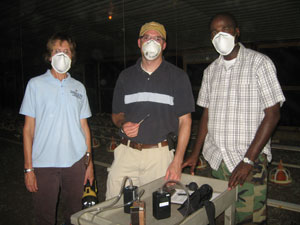 Purpose:Bacteria and fungi have been reported as components of the organic dust produced in
poultry facilities. All previous investigations have utilized culture-based methods
that identifyonlybiota cultured on selected media. Modern pyrosequencing offers a
comprehensive approach to determinebiodiversityof microorganisms, it has not previously
been used to characterize exposure to microorganisms in an occupational environment.
Purpose:Bacteria and fungi have been reported as components of the organic dust produced in
poultry facilities. All previous investigations have utilized culture-based methods
that identifyonlybiota cultured on selected media. Modern pyrosequencing offers a
comprehensive approach to determinebiodiversityof microorganisms, it has not previously
been used to characterize exposure to microorganisms in an occupational environment.Nonnenmann MW, Bexstine B, Dowd SE, Gilmore KH, Levin JL, (2010) Culture-independent characterization of bacteria and fungi in a poultry bioaerosol using pyrosequencing: a new approach. J Occup Environ Hygiene. Dec; 7(12):693-9.
Animal Handling Safety for Dairy Workers – 2010
Molly Smith, Master’s Student, Dept of Agriculture and Home Economics, New Mexico State University
Dairy Parlor Worker Exposure to Organic Dust, Endotoxin and Bacteria – 2010
Aika Hussain, Master’s Candidate, Occupational and Environmental Health, The University of Texas Health Science Center at Tyler
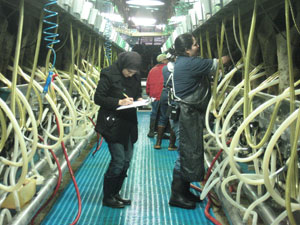 Purpose:This study assessed occupational exposure to organic dust, endotoxinandbacteria exposure
levels among dairy parlor workers and validation of exposure reduction when a parlor
washing treatment was used.
Purpose:This study assessed occupational exposure to organic dust, endotoxinandbacteria exposure
levels among dairy parlor workers and validation of exposure reduction when a parlor
washing treatment was used.
Risk Factors for Musculoskeletal Symptoms Among Louisiana Crawfish Farmers – 2010
Matt Nonnenmann PhD, CIH, Assistant Professor, The University of Texas Health Science Center at Tyler
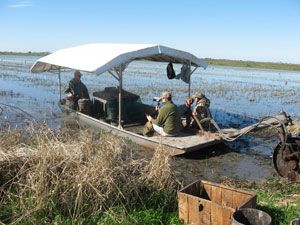 Purpose:The objective of this project was to determine the prevalence of musculoskeletal symptoms
(MSS) among crawfish farmers in Southern Louisiana. MSS stress was measured during
routine harvesting tasks in a sample of crawfish farmers. This feasibility study applied
formal ergonomic methods toevaluationof an aquaculture worker population.
Purpose:The objective of this project was to determine the prevalence of musculoskeletal symptoms
(MSS) among crawfish farmers in Southern Louisiana. MSS stress was measured during
routine harvesting tasks in a sample of crawfish farmers. This feasibility study applied
formal ergonomic methods toevaluationof an aquaculture worker population.
Analysis of Pesticide Exposure Among Mexican Immigrant Farmworkers – 2009
S. Amy Snipes, PhD, The University of Texas M.D. Anderson Cancer Center
Agency Preparedness Response for AgroTerrorism Event – 2009
Randall Craig, MD, Occupational Medicine resident, The University of Texas Health Science Center at Tyler
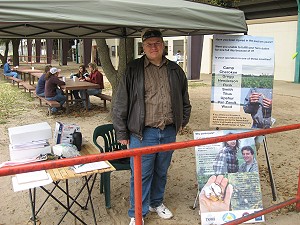
Farmers’ / Ranchers’ Perceptions on Disability – 2008
Purpose: This study examined the perceptions of farmers and ranchers with regard to the experience
of subjects who sought and followed advice from a healthcare professional with regard
to their disability and work restrictions compared to that of subjects who did not.Nicholas Bingham, MD,MS
2007 – 2008
Environmental/Occupational Exposures & Parkinson’s Disease in East Texas – 2008
Amanpreet Dhillon, MD, MS
Analysis of Factors Contributing to Commercial Fishing Vessel Incidents in U.S. Coast
Guard Region 8 – 2006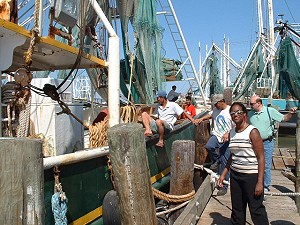
Sacha St. Hill, MD, MS
Purpose: The U.S. Coast Guard Region 8 office in New Orleans, LA shared its database of information concerning commercial fishing vessel incidents in its jurisdictional waters for a two-year period.
2005 – 2006
Occupational Injury Reporting by Farmworkers – 2004
Cynthia Ball, DO, MS
Integrating and Adapted Occupational Health Curriculum Into the Farmworker High School Equivalency Program in Brownsville, TX – 2004 M.
Soledad Vela-Acosta, MD, MS, PhD
Establishing Exposure Risk for Noise and Organic Solvents Among Farmers – 2004
Annette Hurley, MS, CCC-A
Purpose: It is estimated that nearly 20 million workers in the U.S. are exposed to hazardous levels of noise in the workplace. Further evidence has shown that as many as 30 million American workers may be exposed to hazardous noise and ototoxic chemicals. To date, no published studies have reported hearing loss among agricultural workers as it relates to the type and extent of concomitant pesticide exposure. This feasibility study seeks to assess the risk from both noise and organic solvent exposure from which a risk assessment tool can be developed. This tool will be used to establish methods of data collection for both noise dosimetry and organic solvent exposure in order to pursue future funding to evaluate the two exposures and their effect on threshold shifts.
2003 – 2004
The Use of Syndromic Surveillance to Detect Naturally Occurring or Intentionally Introduced Zoonotic Disease in Agricultural Workers – 2004
Laura Banks, DVM Cameron Crandall, MD
Purpose: To evaluate the feasibility of using syndromic surveillance in the agricultural setting to detect zoonotic diseases in agricultural workers. This surveillance could be conducted independently of, or in concert with, surveillance for diseases in animals. This study will entail structured interviews with key informants to answer the following questions: What are the possible sources of disease syndrome or symptom data? What is the utility of the currently available syndromic surveillance equipment and procedures in agricultural situations? What is the willingness of the agricultural community to support surveillance for diseases other than those mandated by health officials? What are the current methods of data analysis and the utility of the user feedback to the health of agricultural workers? What are the implications for joint human/animal disease surveillance?
2003 – 2004
Health and Safety Needs Assessment of Medically Uninsured and Underinsured Farm Workers in East Texas – 2003
Eva Doyle, PhD, MSEd, CHES Mr. Robin Rager, PhD, CHES